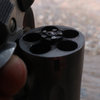edwardware
Member
- Joined
- Feb 23, 2010
- Messages
- 4,424
Had an interesting malfunction in my 642 this afternoon at the range. The weapon is probably ~1 year of pocket carry and 100 rounds from it's last complete teardown.
Unloaded, showed clear, reloaded, fired 5, shucked brass, reloaded. . . and the trigger's dead, locked forward. . .

A closer look shows the cylinder center pin stuck forward in the extractor rod. It was barely stuck, and could be pushed back into place with a finger on the exposed end of the extractor rod locking bolt, but would not return home under it's own spring.
A teardown and cleaning reveals the usual pocket woolyboogers, and perhaps the center pin spring installed backward (unwound end on the pin boss instead of the extractor rod end).
It must have picked up a fleck of grit into the pin way in the extractor, and with the spring backwards that was just enough to bind it up. This is surprising, especially after a thorough workout since the last disassembly. I'm certainly glad it happened on a square range.
Unloaded, showed clear, reloaded, fired 5, shucked brass, reloaded. . . and the trigger's dead, locked forward. . .

A closer look shows the cylinder center pin stuck forward in the extractor rod. It was barely stuck, and could be pushed back into place with a finger on the exposed end of the extractor rod locking bolt, but would not return home under it's own spring.
A teardown and cleaning reveals the usual pocket woolyboogers, and perhaps the center pin spring installed backward (unwound end on the pin boss instead of the extractor rod end).
It must have picked up a fleck of grit into the pin way in the extractor, and with the spring backwards that was just enough to bind it up. This is surprising, especially after a thorough workout since the last disassembly. I'm certainly glad it happened on a square range.


 (That's a hint he'd waited too long to bring it to our attention.
(That's a hint he'd waited too long to bring it to our attention.  ) When I removed the cylinder & yoke to check it, the alloy yoke was both fouled and bone dry. A quick wipe down and a couple drops of CLP to the bearing surfaces restored the little revolver to normal function. The guy was amazed. Since he carried that PD snub as a working secondary weapon (or even as a "primary" during his normal undercover assignment), I showed him how to remove the cylinder and yoke, and check for normal lube on the yoke's front & rear bearing surfaces, and how to be alert to avoiding stripping the SC/AL frame when reinstalling the yoke screw.
) When I removed the cylinder & yoke to check it, the alloy yoke was both fouled and bone dry. A quick wipe down and a couple drops of CLP to the bearing surfaces restored the little revolver to normal function. The guy was amazed. Since he carried that PD snub as a working secondary weapon (or even as a "primary" during his normal undercover assignment), I showed him how to remove the cylinder and yoke, and check for normal lube on the yoke's front & rear bearing surfaces, and how to be alert to avoiding stripping the SC/AL frame when reinstalling the yoke screw.